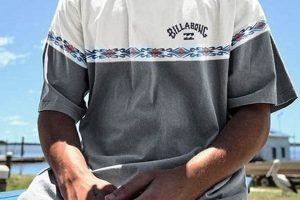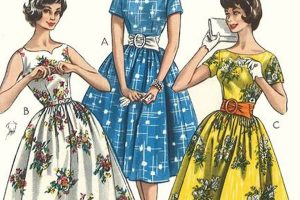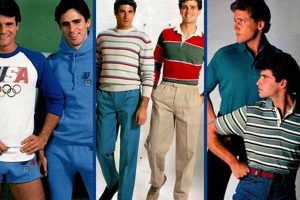Garments and accessories from the esteemed House of Chanel, originating from prior decades, constitute a significant segment of the luxury resale market. These items, reflective of distinct eras and creative directions within the brand’s history, offer a tangible connection to the evolution of fashion and design. A classic example might be a tweed suit from the 1980s, instantly recognizable for its iconic silhouette and luxurious fabrication.
Possessing pieces from Chanel’s past provides access to unparalleled craftsmanship and enduring style. These articles often appreciate in value, becoming coveted collectibles. Furthermore, acquiring such items represents a commitment to sustainability, promoting the reuse and preservation of high-quality goods. Their historical significance provides insight into the cultural and artistic landscape that shaped the brand’s legacy.
The following discussion will delve into the identification, authentication, and preservation of these treasured items. Specific focus will be given to evaluating material condition, recognizing hallmark design elements, and navigating the complexities of the secondary market. Ultimately, the aim is to provide clarity for both seasoned collectors and those new to appreciating the lasting allure of classic Chanel.
Acquiring Chanel Garments from Previous Eras
The procurement of apparel and accessories originating from Chanel’s past requires a discerning approach. The following guidelines aim to facilitate informed decisions and ensure the authenticity and value of potential acquisitions.
Tip 1: Conduct Thorough Authentication. Verify authenticity through expert appraisal or reputable authentication services. Scrutinize labels, hardware, and construction techniques for inconsistencies indicative of counterfeit items. Examine serial numbers (if present) and compare them to known Chanel production patterns.
Tip 2: Assess Condition Meticulously. Evaluate the garment’s overall state, paying close attention to areas prone to wear and tear, such as linings, closures, and edges. Request detailed photographs or, ideally, inspect the item in person. Factor restoration costs into the purchase price.
Tip 3: Research the Era of Origin. Understanding the specific design characteristics associated with different decades of Chanel production aids in identifying both authenticity and potential value. Familiarize yourself with hallmark silhouettes, fabrics, and embellishments relevant to the period.
Tip 4: Scrutinize Seller Reputation. Prioritize established and reputable vendors specializing in luxury resale. Review seller feedback, guarantees, and return policies before committing to a purchase. Obtain proof of purchase or provenance whenever possible.
Tip 5: Verify Sizing and Fit. Sizing standards have evolved over time. Obtain precise measurements of the garment and compare them to your own to ensure a suitable fit. Consider the potential costs of alterations, particularly for complex designs.
Tip 6: Understand Market Value Fluctuations. Research comparable items sold recently to establish a reasonable market price. Consider factors such as rarity, condition, and historical significance when evaluating value. Be wary of prices that appear significantly below market averages.
Acquiring Chanel garments from previous eras offers an opportunity to own a piece of fashion history. Adhering to these guidelines minimizes risk and maximizes the potential for a successful acquisition, ensuring both satisfaction and the preservation of these valuable artifacts.
The subsequent discussion will focus on the proper care and preservation techniques necessary to maintain the integrity and value of these treasured pieces for future generations.
1. Era Identification
Era Identification, within the context of Chanel garments from previous decades, is paramount. Accurate determination of the production period directly influences valuation, authentication, and appropriate preservation strategies. Understanding the prevailing design aesthetics, materials, and manufacturing techniques characteristic of specific eras is essential for responsible acquisition and stewardship.
- Silhouette and Construction Techniques
Each era witnessed distinct silhouettes and construction methods. For example, the structured, boxy shapes prevalent in the 1980s contrast sharply with the more fluid lines of the 1930s. Understanding these shifts in form and internal construction details, such as shoulder padding or seam finishes, aids in narrowing down the period of origin. Changes in manufacturing processes also reflect technological advancements across decades.
- Fabric and Embellishment Styles
The materials employed, and the embellishments applied, offer significant clues. The use of specific types of tweed, lace, or buttons is often associated with particular eras. For instance, certain textured wools and overtly ornamental details might be indicative of Chanel’s collections during the 1960s. Conversely, minimalist designs with simpler fabrics could point to later periods. These elements are critical identifiers.
- Label Evolution and Markings
Chanel’s label design and associated markings have undergone numerous changes over the years. The font, logo style, and placement of the “Made in France” designation, as well as the presence or absence of serial numbers or hologram stickers, are valuable indicators. A thorough knowledge of the evolution of these markings is essential for discerning authenticity and dating the garment accurately.
- Hardware and Closure Systems
Zippers, buttons, clasps, and other hardware components can provide dating insights. The type of metal used, the design of the closures, and the presence of Chanel branding on these elements are all factors to consider. For example, early Chanel handbags often feature unique clasp designs that differ significantly from those found on later models. Changes in closure technology reflect the passage of time.
The ability to accurately identify the era of a Chanel garment is fundamental to appreciating its historical context and assessing its authenticity and value. A comprehensive understanding of these facets allows collectors and enthusiasts to navigate the complexities of the vintage market with greater confidence. Moreover, it ensures responsible preservation efforts tailored to the specific needs of each piece.
2. Material Integrity
The enduring value and desirability of garments and accessories from Chanel’s past are inextricably linked to the concept of Material Integrity. The selection of high-quality fabrics and components, coupled with meticulous construction techniques, directly impacts the lifespan and aesthetic appeal of these items. Deterioration of constituent materials, whether through improper storage, wear and tear, or inherent vulnerabilities, diminishes both monetary worth and historical significance. A Chanel tweed jacket from the 1960s, originally crafted from premium Scottish wool, exemplifies this principle. If the wool fibers are compromised by moth damage or prolonged exposure to sunlight, the garment’s structure, appearance, and collectibility are substantially reduced.
Assessing Material Integrity requires a nuanced understanding of textile science and conservation principles. Vintage Chanel pieces often incorporate delicate or rare materials, such as silk chiffon, intricate lace, or specialized leather finishes. Each material possesses unique vulnerabilities and degradation pathways. For example, vintage leather goods can become brittle and prone to cracking if not properly conditioned, while silk may exhibit color fading or fiber weakening due to light exposure and humidity. The impact of past cleaning methods and storage conditions must also be considered, as inappropriate practices can accelerate deterioration. Consequently, preserving these items demands specialized knowledge and careful handling.
In summary, Material Integrity constitutes a cornerstone of the long-term value and historical relevance. Understanding the specific vulnerabilities of different materials and implementing appropriate preservation measures are crucial for ensuring that these garments and accessories retain their aesthetic appeal and structural soundness. The challenges associated with preserving delicate or aged materials underscore the importance of proactive care and responsible handling, thereby safeguarding these cultural artifacts for future generations.
3. Authenticity Markers
The verification of garments and accessories originating from Chanel’s past relies heavily on the identification and assessment of specific Authenticity Markers. These identifying characteristics, inherent to genuine Chanel products, serve as critical differentiators in distinguishing authentic items from counterfeit reproductions. Their presence, consistency, and conformity to established Chanel production standards are paramount in confirming the provenance and value of vintage pieces.
- Label Details and Placement
Chanel labels, over the decades, exhibit variations in font, logo style, and construction. The precise placement, stitching quality, and material composition of the label are crucial indicators. For instance, certain label designs are specific to particular eras, and deviations from these established patterns raise immediate concerns. The thread count, weave pattern, and attachment method of the label to the garment must align with known Chanel practices.
- Hardware and Embellishment Consistency
Authentic Chanel utilizes high-quality hardware, including zippers, buttons, and clasps. These components often bear the Chanel logo or other identifying marks. The consistency of the hardware finish, the precision of the engravings, and the overall quality of the materials employed are vital authenticity indicators. Similarly, the embellishments, such as sequins, beads, or embroidery, should exhibit impeccable craftsmanship and adherence to Chanel’s design standards. Variations in material, application, or finishing suggest potential inauthenticity.
- Serial Numbers and Hologram Stickers
Since the mid-1980s, Chanel has incorporated serial numbers and hologram stickers into its handbags and accessories. These identifying features provide a unique code that can be traced back to the item’s production date and origin. The presence, format, and integrity of these serial numbers and hologram stickers are essential authenticity markers. However, it is important to note that counterfeiters have become increasingly sophisticated in replicating these features, necessitating careful scrutiny and cross-referencing with established authentication databases.
- Construction and Stitching Quality
Chanel garments are renowned for their exceptional construction and meticulous stitching. The seams should be straight, even, and securely finished. The stitching density, thread type, and overall precision of the construction are indicative of authentic Chanel craftsmanship. Variations in these aspects, such as uneven seams, loose threads, or inferior stitching quality, can indicate a counterfeit item.
The diligent examination of these Authenticity Markers, in conjunction with expert appraisal and a thorough understanding of Chanel’s historical production practices, provides a robust framework for verifying the authenticity of Chanel garments from previous eras. The absence or inconsistency of these markers should raise concerns and warrant further investigation, ultimately safeguarding collectors and enthusiasts from acquiring counterfeit items. The complexity underscores the need for expertise in navigating the Chanel market.
4. Craftsmanship Quality
Craftsmanship Quality stands as a cornerstone in assessing the value and desirability of Chanel garments from previous decades. It transcends mere aesthetic appeal, representing the skill, dedication, and attention to detail invested in the creation of each piece. High standards of craftsmanship ensure longevity, preserve historical accuracy, and contribute significantly to an item’s collectibility.
- Seam Construction and Finishing
The internal structure of Chanel garments reflects an unwavering commitment to quality. Seams are meticulously reinforced, often utilizing techniques such as hand-stitching or intricate overlocking to prevent fraying and ensure structural integrity. The precise alignment of patterns, the uniformity of stitch length, and the absence of puckering or distortion are hallmarks of superior craftsmanship. A Chanel jacket, for example, will exhibit perfectly aligned lining and meticulously finished raw edges, showcasing a level of detail rarely found in mass-produced garments.
- Fabric Selection and Handling
Garments from Chanel’s past often feature rare and luxurious materials, such as hand-woven tweeds, exquisite silks, and supple leathers. The selection of these fabrics, coupled with their careful handling during the construction process, is critical to the overall quality. Authentic Chanel garments exhibit a superior drape, texture, and hand-feel, reflecting the inherent properties of the chosen materials and the expertise of the artisans who worked with them. Evidence of careful pattern matching and minimal fabric waste further underscores the commitment to quality.
- Hardware and Embellishment Application
The hardware components and embellishments featured on Chanel garments are integral to their design and contribute significantly to their overall aesthetic appeal. Zippers, buttons, clasps, and decorative elements, such as sequins, beads, and embroidery, are meticulously applied and securely fastened. Authentic Chanel hardware is typically crafted from high-quality metals and bears the brand’s logo or other identifying marks. The precision and artistry of the embellishment application, whether achieved through hand-stitching or specialized machinery, are indicative of superior craftsmanship.
- Lining and Interfacing Techniques
The internal construction of a Chanel garment is as important as its external appearance. Linings are carefully selected to complement the outer fabric and provide structure, comfort, and durability. Interfacing materials are strategically employed to reinforce specific areas, such as collars, lapels, and cuffs, ensuring that the garment retains its shape and structure over time. The quality of the lining and interfacing, as well as the precision with which they are integrated into the garment, are essential indicators of superior craftsmanship.
The assessment of Craftsmanship Quality provides invaluable insight into the authenticity, value, and long-term desirability of vintage Chanel. Recognizing the nuanced details of construction, material selection, and embellishment application allows collectors and enthusiasts to appreciate the artistry and dedication that define these iconic garments, ultimately contributing to their preservation and appreciation for future generations. The enduring appeal of these items stems not only from their brand recognition but also from their inherent quality and timeless elegance.
5. Historical Significance
The historical significance of Chanel garments from prior decades transcends simple aesthetic appreciation, positioning these items as tangible artifacts reflecting evolving social, economic, and artistic landscapes. Their value lies not only in the brand’s legacy but also in their embodiment of pivotal moments in fashion history and cultural shifts.
- Reflection of Societal Shifts
Chanel’s designs often mirrored and, at times, influenced societal changes. The relaxed silhouettes of the 1920s reflected a newfound liberation for women, while the utility-driven styles of the wartime era mirrored resource constraints and practical needs. Examining these garments provides insight into the zeitgeist of each era and their impact on sartorial expression. For example, the increasing popularity of Chanel knitwear in the 1960s spoke to a broader movement towards more casual and accessible luxury.
- Evolution of Design Aesthetics
Each decade of Chanel production showcases an evolution of design principles and stylistic innovations. From the revolutionary jersey dresses of the early years to the iconic tweed suits and chain-strapped handbags that followed, these pieces trace the development of a distinct Chanel aesthetic. Studying these changes provides a framework for understanding the brand’s enduring appeal and its ability to adapt to changing tastes while maintaining a core identity. The transition from highly ornamented designs to cleaner, more streamlined silhouettes in later decades exemplifies this evolution.
- Impact of Artistic Influences
Chanel frequently drew inspiration from the art world, incorporating motifs and techniques from various artistic movements into its designs. The influence of Cubism, Surrealism, and other avant-garde styles can be observed in the patterns, textures, and construction of Chanel garments from different periods. Recognizing these influences provides a deeper appreciation for the intellectual and creative context that shaped the brand’s output. The use of geometric patterns in some Chanel accessories, for example, echoes the principles of early 20th-century abstract art.
- Legacy of Innovation
Chanel’s innovations, such as the popularization of jersey fabric in haute couture and the introduction of the little black dress, have had a lasting impact on fashion. Preserving garments that embody these groundbreaking ideas helps to safeguard the brand’s legacy and inspire future generations of designers. These items serve as tangible reminders of Chanel’s pioneering spirit and its role in shaping modern fashion. The quilted handbag with a chain strap, for instance, revolutionized handbag design and remains a signature Chanel creation.
These interconnected facets underscore the significance of Chanel garments from previous eras as more than just fashion items; they are historical documents. Their preservation and study contribute to a broader understanding of cultural evolution and the enduring influence of Chanel on the world of fashion and beyond. Understanding the historical framework helps to contextualize the collectibility and valuation of these important pieces, contributing to a more informed appreciation.
6. Collectibility Factor
The collectibility factor, in the context of garments and accessories from Chanel’s past, represents the confluence of multiple attributes that elevate specific items beyond mere utility and into the realm of coveted acquisitions. This multifaceted concept significantly influences valuation and desirability within the vintage luxury market.
- Rarity and Limited Production
Items produced in limited quantities, special editions, or collaborations with renowned artists often command higher prices due to their scarcity. A Chanel handbag from a specific season, featuring a unique material or design element, becomes more desirable if only a small number were manufactured. For example, a Chanel piece created in collaboration with a famous artist sees a significant increase in collectibility due to its limited availability and unique artistic value.
- Iconic Design and Historical Significance
Garments and accessories that represent pivotal moments in Chanel’s history or embody iconic design elements are highly sought after by collectors. The classic Chanel tweed suit, the 2.55 handbag, and the little black dress are prime examples of pieces that have achieved iconic status and retain enduring appeal. Pieces worn by influential figures in their time or those directly tied to a particular historical event often see higher collectibility. A Chanel piece known to be worn by a famous actress during a seminal film boosts its collectibility.
- Condition and Provenance
The physical condition of a garment and its documented history, or provenance, significantly impact its collectibility. Items in pristine condition, with minimal signs of wear and tear, are generally more valuable than those exhibiting damage or alterations. Provenance, which includes documentation of previous ownership, authenticity certificates, or historical records, adds credibility and increases desirability. Garments from Chanel’s past with verifiable ownership historyfor instance, items once belonging to a notable celebrityenhance the collectibility substantially.
- Market Trends and Demand
Shifting market trends and consumer demand play a crucial role in determining the collectibility of Chanel’s pieces. Fluctuations in fashion preferences, celebrity endorsements, and the emergence of new collectors can all influence the desirability and value of specific items. The increased visibility of Chanel in popular culture or the revival of vintage styles can drive demand for specific pieces. The surge in popularity of 1990s Chanel accessories, for instance, illustrates how market trends shape collectibility.
The interplay of rarity, iconic status, condition, provenance, and market trends ultimately determines the collectibility factor of items from Chanel’s past. These elements intertwine, creating a complex and dynamic ecosystem that drives valuation within the vintage luxury market. Recognizing these factors empowers collectors and enthusiasts to make informed decisions, ensuring they acquire pieces with lasting value and historical significance.
7. Valuation Dynamics
The valuation dynamics surrounding garments and accessories originating from Chanel’s past are complex, influenced by an array of interconnected factors that determine market price and investment potential. These dynamics are not static; they shift according to trends, historical context, and the intrinsic qualities of individual pieces. Understanding these forces is paramount for collectors, investors, and enthusiasts seeking to navigate the vintage luxury market effectively. For instance, a Chanel tweed suit from the 1960s, initially purchased for a few hundred dollars, may now command thousands due to its rarity, historical significance, and the enduring appeal of its design. This increase exemplifies the impact of market forces on these items.
Key determinants within these valuation dynamics include the garment’s condition, provenance, rarity, and historical significance. Items in excellent condition, with documented history and limited production numbers, typically command higher prices. Market trends and consumer demand also exert a significant influence. A renewed interest in a specific era of Chanel’s design, fueled by media attention or celebrity endorsements, can drive up prices for representative pieces. Authenticity is a non-negotiable factor; unverified items face drastic devaluation. The process of authentication often requires expert consultation and detailed examination of construction, materials, and labeling, thus adding to the overall cost and complexity of valuation.
In conclusion, the valuation dynamics governing garments and accessories originating from Chanel’s past are a product of multifaceted variables, ranging from intrinsic qualities to external market forces. Accurate assessment demands a comprehensive understanding of these factors and a willingness to engage expert resources. The vintage Chanel market presents both opportunities and challenges, requiring discerning judgment and meticulous due diligence to ensure informed decision-making. Failing to account for these valuation dynamics can lead to misinformed purchases and compromised investment returns, emphasizing the need for expert guidance.
Frequently Asked Questions
This section addresses common inquiries regarding the acquisition, authentication, and care of apparel and accessories from Chanel’s past. The information provided aims to clarify prevailing misconceptions and offer practical guidance for enthusiasts and collectors.
Question 1: How can one determine the authenticity of a Chanel garment originating from a previous era?
Authentication involves a meticulous examination of various factors, including label details, hardware consistency, serial numbers (if present), stitching quality, and overall construction. Comparison with known authentic examples and expert appraisal are recommended to mitigate the risk of acquiring counterfeit items.
Question 2: What are the key indicators of condition when evaluating vintage Chanel clothing?
Assess the overall state of the garment, paying close attention to areas prone to wear and tear, such as linings, closures, and edges. Inspect for damage, staining, fading, and alterations. Factor restoration costs into the purchase price.
Question 3: How should vintage Chanel garments be stored to prevent damage?
Store garments in a cool, dry, and dark environment, away from direct sunlight and excessive humidity. Use padded hangers to maintain shape and prevent stretching. Consider acid-free storage boxes or garment bags for long-term preservation.
Question 4: What cleaning methods are appropriate for vintage Chanel clothing?
Professional dry cleaning by a reputable specialist experienced in handling delicate fabrics is generally recommended. Avoid washing garments at home, as this can cause damage and distortion. Spot cleaning with gentle, pH-neutral detergents may be appropriate for minor stains, but always test in an inconspicuous area first.
Question 5: How does the era of origin affect the value of Chanel garments from previous decades?
Garments from certain eras may be more desirable and valuable due to their rarity, historical significance, or iconic design elements. Familiarity with Chanel’s historical collections is essential for understanding the nuances of valuation.
Question 6: What resources are available for researching the history of Chanel’s designs and production?
Museum archives, libraries, and specialized publications offer valuable information. Online databases and auction records provide insights into market trends and pricing. Expert appraisers and authentication services can provide professional guidance.
The preservation and appreciation of garments from Chanel’s past require informed decision-making and meticulous care. These answers aim to equip collectors and enthusiasts with essential knowledge to navigate this complex market successfully.
The subsequent discussion will explore the ongoing impact of the brand on contemporary fashion and its enduring appeal to future generations.
Conclusion
The preceding exploration has illuminated the multifaceted aspects of vintage clothing Chanel, encompassing its identification, authentication, preservation, and valuation dynamics. The inherent value extends beyond mere monetary worth, encompassing historical significance, craftsmanship quality, and collectibility factor. Proper care and informed acquisition are paramount to preserving these pieces for future generations.
The enduring appeal of vintage clothing Chanel lies in its embodiment of timeless elegance and historical relevance. Continued scholarship and responsible stewardship are essential to ensuring the preservation of this important facet of fashion history, allowing future generations to appreciate its artistic merit and cultural impact. The onus rests upon collectors, enthusiasts, and institutions alike to safeguard this legacy.







